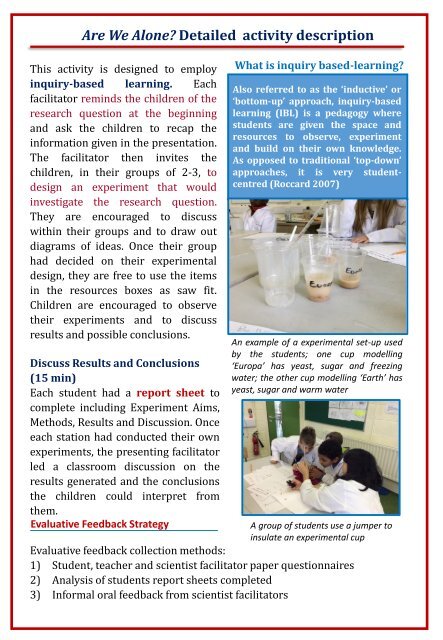biochem report MG
You also want an ePaper? Increase the reach of your titles
YUMPU automatically turns print PDFs into web optimized ePapers that Google loves.
Are We Alone? Detailed activity description<br />
This activity is designed to employ<br />
inquiry-based learning. Each<br />
facilitator reminds the children of the<br />
research question at the beginning<br />
and ask the children to recap the<br />
information given in the presentation.<br />
The facilitator then invites the<br />
children, in their groups of 2-3, to<br />
design an experiment that would<br />
investigate the research question.<br />
They are encouraged to discuss<br />
within their groups and to draw out<br />
diagrams of ideas. Once their group<br />
had decided on their experimental<br />
design, they are free to use the items<br />
in the resources boxes as saw fit.<br />
Children are encouraged to observe<br />
their experiments and to discuss<br />
results and possible conclusions.<br />
Discuss Results and Conclusions<br />
(15 min)<br />
Each student had a <strong>report</strong> sheet to<br />
complete including Experiment Aims,<br />
Methods, Results and Discussion. Once<br />
each station had conducted their own<br />
experiments, the presenting facilitator<br />
led a classroom discussion on the<br />
results generated and the conclusions<br />
the children could interpret from<br />
them.<br />
Evaluative Feedback Strategy<br />
What is inquiry based-learning?<br />
Also referred to as the ‘inductive’ or<br />
‘bottom-up’ approach, inquiry-based<br />
learning (IBL) is a pedagogy where<br />
students are given the space and<br />
resources to observe, experiment<br />
and build on their own knowledge.<br />
As opposed to traditional ‘top-down’<br />
approaches, it is very studentcentred<br />
(Roccard 2007)<br />
An example of a experimental set-up used<br />
by the students; one cup modelling<br />
‘Europa’ has yeast, sugar and freezing<br />
water; the other cup modelling ‘Earth’ has<br />
yeast, sugar and warm water<br />
A group of students use a jumper to<br />
insulate an experimental cup<br />
Evaluative feedback collection methods:<br />
1) Student, teacher and scientist facilitator paper questionnaires<br />
2) Analysis of students <strong>report</strong> sheets completed<br />
3) Informal oral feedback from scientist facilitators


